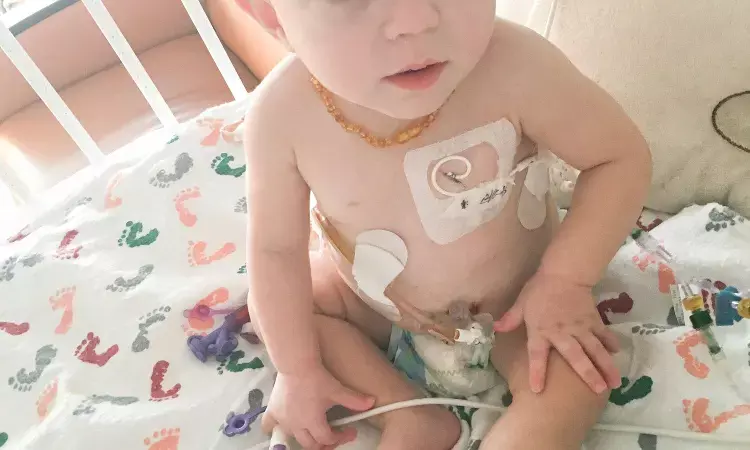- Home
- Medical news & Guidelines
- Anesthesiology
- Cardiology and CTVS
- Critical Care
- Dentistry
- Dermatology
- Diabetes and Endocrinology
- ENT
- Gastroenterology
- Medicine
- Nephrology
- Neurology
- Obstretics-Gynaecology
- Oncology
- Ophthalmology
- Orthopaedics
- Pediatrics-Neonatology
- Psychiatry
- Pulmonology
- Radiology
- Surgery
- Urology
- Laboratory Medicine
- Diet
- Nursing
- Paramedical
- Physiotherapy
- Health news
- Fact Check
- Bone Health Fact Check
- Brain Health Fact Check
- Cancer Related Fact Check
- Child Care Fact Check
- Dental and oral health fact check
- Diabetes and metabolic health fact check
- Diet and Nutrition Fact Check
- Eye and ENT Care Fact Check
- Fitness fact check
- Gut health fact check
- Heart health fact check
- Kidney health fact check
- Medical education fact check
- Men's health fact check
- Respiratory fact check
- Skin and hair care fact check
- Vaccine and Immunization fact check
- Women's health fact check
- AYUSH
- State News
- Andaman and Nicobar Islands
- Andhra Pradesh
- Arunachal Pradesh
- Assam
- Bihar
- Chandigarh
- Chattisgarh
- Dadra and Nagar Haveli
- Daman and Diu
- Delhi
- Goa
- Gujarat
- Haryana
- Himachal Pradesh
- Jammu & Kashmir
- Jharkhand
- Karnataka
- Kerala
- Ladakh
- Lakshadweep
- Madhya Pradesh
- Maharashtra
- Manipur
- Meghalaya
- Mizoram
- Nagaland
- Odisha
- Puducherry
- Punjab
- Rajasthan
- Sikkim
- Tamil Nadu
- Telangana
- Tripura
- Uttar Pradesh
- Uttrakhand
- West Bengal
- Medical Education
- Industry
Central line associated bloodstream infections tied to appreciable morbidity and mortality

Central line associated bloodstream infections tied to increased morbidity
Researchers have found recently that patients with tunnelled catheters, recent clinic visits, and low serum albumin levels have a higher risk of developing ambulatory CLABSIs (central line-associated bloodstream infections). The research findings have been published in the journal PEDIATRICS of American Academy of pediatrics on Dec 1, 2020.
Inpatient pediatric central line-associated bloodstream infections (CLABSIs) cause morbidity and increased health care use. Minimal information exists for ambulatory CLABSIs despite ambulatory central line (CL) use in children. For this purpose, researchers conducted a study to evaluate the ambulatory pediatric CLABSI incidence density, risk factors, and outcomes.
It was a retrospective cohort with nested case-control study at 5 sites from 2010 through 2015. Researchers used electronic queries to identify potential cases based on line-administrative and laboratory data. Using queries they identified a total of 4600 potentially at-risk children among which 1658 (36) had ambulatory CLs. By chart review, they confirmed ambulatory Central Line use and adjudicated CLABSIs. They used bivariate followed by multivariable backward logistic regression method to identify ambulatory CLABSI risk factors. The ambulatory CLABSIs were defined as positive blood cultures drawn < 48 hours after admission to a hospital or > 48 hours after discharge from a hospital.
Key findings of the study were:
♦ The researchers reported 247 (15) patients experienced 466 ambulatory CLABSIs with an incidence density of 0.97 CLABSIs per 1000 CL days.
♦ They noted incidence density was higher among patients with tunnelled externalized catheters when compared with patients who had peripherally inserted central catheters or total implantable devices (1.46 and 0.23 respectively).
♦ In a multivariable model, the researchers found a positive association between clinic visit (odds ratio [OR] 2.8) and low albumin (OR 2.3) with CLABSI.
♦ They also found CLs placed in an operating room (OR 0.36) and use of prophylactic antimicrobial agents within the preceding 30 days (OR=0.22) reduced the odds of CLABSIs.
♦ They noted 396 patients (85) were hospitalized because of ambulatory CLABSI with an 8-day median length of stay (interquartile range 5–13).
The authors concluded, "Ambulatory pediatric CLABSI incidence density is appreciable and associated with health care use. CL type, patients with low albumin, prophylactic antimicrobial agents, and placement setting may be targets for reduction efforts".
For further information:
https://pediatrics.aappublications.org/content/early/2020/12/16/peds.2020-0524
Medical Dialogues Bureau consists of a team of passionate medical/scientific writers, led by doctors and healthcare researchers. Our team efforts to bring you updated and timely news about the important happenings of the medical and healthcare sector. Our editorial team can be reached at editorial@medicaldialogues.in.
Dr Kamal Kant Kohli-MBBS, DTCD- a chest specialist with more than 30 years of practice and a flair for writing clinical articles, Dr Kamal Kant Kohli joined Medical Dialogues as a Chief Editor of Medical News. Besides writing articles, as an editor, he proofreads and verifies all the medical content published on Medical Dialogues including those coming from journals, studies,medical conferences,guidelines etc. Email: drkohli@medicaldialogues.in. Contact no. 011-43720751


